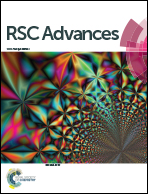Waterborne UV-curable polyurethane acrylate/silica nanocomposites for thermochromic coatings
Abstract
Waterborne UV-curable polyurethane acrylate/silica (PUA/SiO2) nanocomposites were prepared by a sol–gel method. SiO2 nanoparticles were modified by γ-methacryloxypropyltrimethoxysilane (KH-570) and then introduced to the ends of the PUA main chains through radical polymerization. According to the transmission electron microscopy (TEM) results, the size of the PUA/SiO2 nanocomposite particles was approximately 70–100 nm. It was easier to get a uniform emulsion by the sol–gel method than by the physical blending method. Surface tension and contact angle tests both demonstrated the good wettability of the nanocomposites. Besides, the kinetics of the curing process of the PUA/SiO2 films were analyzed by ATR-FTIR and gel content. This revealed that the modified SiO2 could accelerate the curing speed of PUA coatings. Scanning electron microscopy (SEM) and dynamic mechanical analysis (DMA) indicated that the nanosilica were well dispersed in the PUA matrix and the soft and hard segments of PUA/SiO2 were well phase mixed. Furthermore, the nanocomposite films displayed enhanced rigidity, hardness, abrasion resistance and good weather resistance. Finally, waterborne UV-curable PUA/SiO2 nanocomposites were applied to thermochromic coatings, showing excellent temperature sensitivity and reversibility.


 Please wait while we load your content...
Please wait while we load your content...